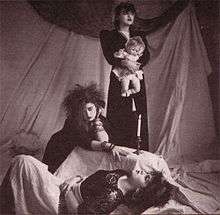Sugar Babydoll
| Sugar Babydoll | |
|---|---|
 Promotional photo of the band in its beginning, with Courtney Love (standing, center) and friends Ursula Wehr and Robin Barbur. | |
| Background information | |
| Origin | Portland, Oregon, U.S. |
| Years active | 1981, 1984 |
| Associated acts |
Pagan Babies The Italian Whorenuns Hole Babes in Toyland L7 |
| Past members |
Courtney Love Kat Bjelland Jennifer Finch Ursula Wehr Robin Barbur |
Sugar Babydoll was a continuous, on-and-off musical project initially formed in Portland, Oregon by Courtney Love in 1981.[1][2][3] The group, which in its latter stages included guitarist/vocalist Kat Bjelland and bassist Jennifer Finch, was a precursor to the Pagan Babies, formed by Love and Bjelland in San Francisco in 1984. In a VH1: Behind the Music documentary on Love, both Love and Bjelland noted that the band, in its early stages, was more about "taking pictures" and having fun rather than playing music.[2][4]
History
Courtney Love had originally come up with the name and idea for the band in the early 1980s when she was a teenager in Portland. She formed the group with friends Ursula Wehr and Robin Barbur in 1981, when Love was seventeen years old,[1] but aborted the project and moved to San Francisco in 1982 where she had a brief stint as a singer for Faith No More. Upon returning to Portland in 1983, Love met Kat Bjelland at the Satyricon nightclub.[2][5] Both Love and Bjelland were frequent visitors to the rock club, known in the 1980s as a hub for punk rock shows and rock musicians. Bjelland was from nearby Woodburn, while Love had lived in various cities throughout the state, including Marcola, Salem, Eugene, and Portland.[2]
According to Bjelland, after the two had met, Love, who was looking to form an all-female rock group, "fell to her knees" and begged "please, please be my guitarist."[2] Bjelland accepted, and Love then recruited Jennifer Finch, a friend she had met while in California, into the group as the bass player.
Little is known about what culminated from the group's musical endeavors; although a demo tape was made from Love and Bjelland's subsequent band, the Pagan Babies, there is no known recording information or history of Sugar Babydoll. What is known, however, was the band's tumultuous breakup. Both Love and Bjelland were experimenting with drugs at the time, and abusing pharmaceuticals, such as Valium. According to Jennifer Finch, Love's drug experimentation began to "interfere with the creative process",[2] to the point that, according to Bjelland, Love would "take all of her clothes off, walk around in circles, talk about stuff— not play music."[2]
Over the next several years, the band moved between Oregon and California, before it was abandoned altogether. By 1985, the group had officially split. Love returned yet again to San Francisco, this time with Bjelland, where they formed another group, the Pagan Babies, which was also short-lived.
Despite the lack of success in the group, all three women would go on to much greater musical projects: Love went on to form the immensely successful Hole in 1989, while Bjelland formed the more low-key, though also successful Babes in Toyland in 1987. Love briefly moved to Minneapolis where Bjelland formed Babes in Toyland, and played bass in the band for several weeks before being ejected and replaced by Michelle Leon.[1] Jennifer Finch would go on to perform in the all-female punk band L7 for its first six years, as well as Betty Blowtorch.
References
- 1 2 3 Marks, Craig (February 1995). "Endless Love". Spin Magazine: 45–48.
- 1 2 3 4 5 6 7 "Behind the Music: Courtney Love". Behind the Music. 21 June 2010. Vh1.
- ↑ St. Thomas, Kurt; Smith, Troy. Nirvana: the chosen rejects. St. Martin's Griffin/Macmillan Press. p. 92. ISBN 978-0-312-20663-5.
- ↑ Bjelland, Kat. E! True Hollywood Story: Courtney Love. E! Networks.
- ↑ Jarman, Casey; Mannheimer, Michael; Horton, Jay (27 October 2010). "I Think I Was There: An oral history of the Satyricon". The Willamette Week. Retrieved 12 February 2011.